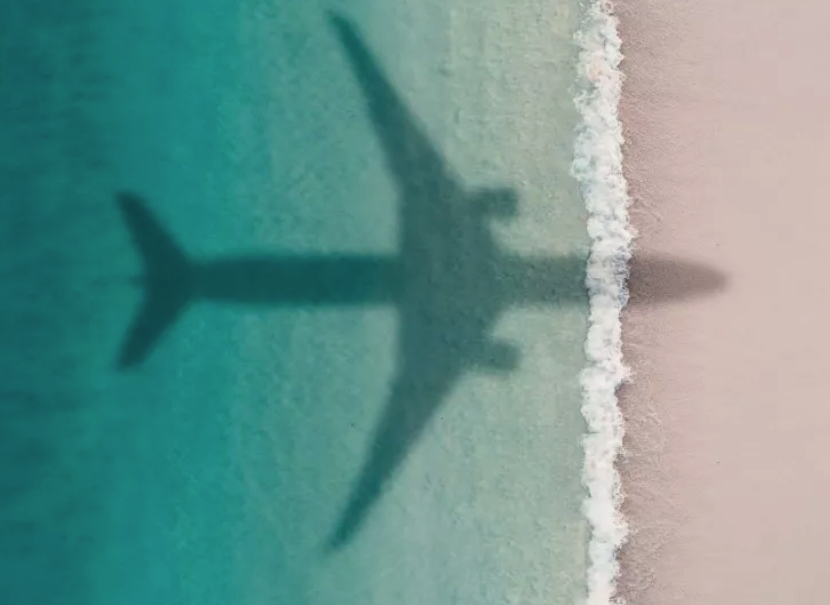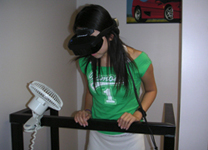Virtual Reality Exposure for Overcoming Fear of Flying
Virutal Reality Medical Center, serving our patients with Virtual Reality for the past 25 years. Contact us at frontoffice@vrphobia.com.

Virutal Reality Medical Center, serving our patients with Virtual Reality for the past 25 years. Contact us at frontoffice@vrphobia.com.

Virtual Reality Exposure Helps Overcome Fears
“Last September, my husband and I celebrated our 25th wedding anniversary and flew from California to Vermont. This was the first time I had flown in years.”
Like many people with aviophobia, Gaustad hadn’t always been afraid of flying. “We actually flew quite a bit. But on a flight to Las Vegas, our plane hit a few air pockets… enough turbulence to throw things around a bit… and although everything turned out okay, I got real real panicky and said, ‘I’m not going to be able to do this again.'” Sure enough, Gaustad and her family traveled by car, bus or train throughout the next decade.
Knowing the anniversary trip was coming up, Gaustad decided to do something about her phobia and learned that virtual reality therapy was available through her company’s employee benefits. “I only met with Brenda seven or eight times before the therapy worked on me,” she recalls. “In fact, before the sessions were completely over, I had already booked our flights to Vermont.”
“Yes I did feel sort of weird when I wasn’t flying, like there was someting wrong with me,” Gaustad admits. “It was important that my husband understood my problem. Be patient and work through this together.”
Contact us at frontoffice@vrphobia.com to learn more.
I had a normal childhood. One of my favorite places in our hometown was our bird farm, where I thought it was very cool to go hang out with birds and touch them. I cannot imagine this anymore.
All of this was until I had a very bad experience one day. I was nine. We were in this park and someone dumped a bag of birdseed in front of me. All of a sudden there I was engulfed in a cloud of sparrows. I couldn’t see anything except brown-white feathers everywhere. And I couldn’t hear anything except for chirping, frantic wing flapping.
I started to feel like I couldn’t breathe. To me this felt like it went on for tens of minutes, even though talking to Brenda, I realized it must have actually been a couple of seconds.
I was really shaken. My parents were like, “Oh, poor baby, let’s go and take her out for some ice cream.” And we did. They sat me down and put some ice cream in front of me. And, a very bold pigeon landed in my plate and started flapping around. There were feathers everywhere and the sound that terrified me a couple of seconds ago was back.
I think that was what cemented the connection between birds and danger in my mind. I think I’ve had this phobia ever since.
When we walk around Palo Alto, we have to take a special route to avoid houses with any chicken coops.
Neha’s Boyfriend
When we walk around in the city, and you see a bird on the sidewalk, you squeeze my hand really tightly and cry.
Neha’s Sister
That time you ran out of the kitchen, screaming and sweating and crying, and it was because there was a feather on the floor.
Neha’s Mom
My mother sent out an email to all of her doctor friends saying, “My daughter runs into traffic to escape pigeons. Can anyone help us?” The answer we got was VR therapy.
I thought, “That sounds made up, and kinda like sci-fi.”
————————————————————————————————————
I can deal with a penguin maybe, a video of a penguin
Neha
Even as a part of the process, there was an option to stop. So I never felt like, “Oh my God, I can’t take it anymore.” It was always under control. It was never something that I felt like I had to get out of immediately.
My goal was to not have bird phobia interrupt my daily life. I wanted to walk within 10 feet of a bird.
If I’m being perfectly honest, I definitely still pay attention to birds. “Oh there’s a bird near me, I’m going to start my breathing exercises.” But, I can function like normal.
For more information on Neha’s story, click here.
Wiederhold’s clinic already uses the technology for medical therapy to help patients deal with PTSD, anxiety, phobias (like fear of flying), pain during medical procedures and chronic pain. She predicts more clinics using VR will pop-up in California and across the country within the near future.
Contact Information:
Virtual Reality Medical Center
9834 Genesee Avenue, Suite 427
La Jolla, California USA
frontoffice @ vrphobia.com
If you are afraid of spiders, then you are not alone. In fact, approximately 55% of women and 18% of men in the United States suffer from arachnophobia, which is the fear of spiders. Virtual Reality Therapy may be able to help you overcome that fear!
Although not everyone who dislikes spiders has the actual phobia, there are some symptoms to watch out for. If you freeze or run away if you see a spider, refuse to go into a room that may have a spider, and if you will not go camping, hiking, or do any other outdoor activities you used to enjoy for fear of seeing a spider, you may have arachnophobia.
According to licensed clinical psychologist Dr. Brenda K. Wiederhold, PhD, MBA, President of the Virtual Reality Medical Center (VRMC) in La Jolla, California, “A phobia is a diagnosable disorder that impacts your life negatively.” But don’t worry, there are treatments that can help. Virtual Reality (VR) exposure therapy helps the sufferer desensitize to the stimuli that causes their phobia. For example, those who have arachnophobia may be exposed to VR scenarios of spiders in a non-threatening way to gradually decrease the fear at the patient’s own individual pace.
Virtual Reality therapy exposes you to the scenarios in the safety and comfort of the therapist’s office. Licensed clinical psychologist Dr. Brenda K. Wiederhold, PhD, MBA, has been practicing Virtual Reality (VR) therapy for over 2 decades. She completed the first randomized controlled clinical trial in 1996 using Virtual Reality and biofeedback to treat patients with phobias. And the VRMC has been successfully performing VR therapy now for 23 years! With a new set of skills on how to react differently and think differently about spiders, followed by gradual exposure through VR, you can be enjoying that camping trip in no time!
Most individuals with a specific phobia require on average one clinical intake session and 10 treatment sessions. If you live in the San Diego area, you can choose to come once a week or twice a week. If you are coming from out of the area, we can accommodate “condensed treatment” where you will experience one VR session per day, each day, Monday-Friday.
Approximately 5% of Americans have the fear of small spaces, or claustrophobia. This fear is actually a specific phobia according to the Diagnostic and Statistical Manual 5 (DSM-5).
Those who suffer from this disorder are afraid of being closed in or have a fear of not being able to get away that can cause a panic attack when getting on an elevator or an airplane. When you feel like you cannot get away if needed, have an excessive fear of being locked in, or go out of your way to avoid being in a small room or any confined space, these are some of the signs of claustrophobia.
However, this specific phobia is treatable and within a few short weeks, you can be free of the fear of small enclosed spaces. With Virtual Reality therapy, you will be gradually exposed to small spaces such as rooms without windows, hallways, tunnels, elevators, and even closets in small increments, at your own individualized pace. So the next time you’re set to visit your friend who lives on the 27th floor, maybe you will be able to take that elevator!
Approximately 5% of Americans have the fear of small spaces, or claustrophobia. This fear is actually a specific phobia according to the Diagnostic and Statistical Manual 5 (DSM-5).
Those who suffer from this disorder are afraid of being closed in or have a fear of not being able to get away that can cause a panic attack when getting on an elevator or an airplane. When you feel like you cannot get away if needed, have an excessive fear of being locked in, or go out of your way to avoid being in a small room or any confined space, these are some of the signs of claustrophobia.
However, this specific phobia is treatable and within a few short weeks, you can be free of the fear of small enclosed spaces. With Virtual Reality therapy, you will be gradually exposed to small spaces such as rooms without windows, hallways, tunnels, elevators, and even closets in small increments, at your own individualized pace. So the next time you’re set to visit your friend who lives on the 27th floor, maybe you will be able to take that elevator!

Let Virtual Reality help you overcome your Fear of Public Speaking!
Although it seems like all of our present day business interactions can be done online, sometimes we may still find we need to give a presentation. The fear of public speaking, speech anxiety, or glossophobia, is the third most common anxiety disorder in the United States and affects more than 20 million Americans at some point. That is about 25% of the population. Whether you are a businessperson or student, homemaker or doctor, a warehouse worker or an attorney, one day you will likely need to speak in front of a large group of people.
Being a confident public speaker can help you advance your career, enhance your relationships with others, or help you to achieve a better grade in school. However, if you feel extreme fear at the thought of talking to a group or get dizzy and nauseous when you have to go on stage, you may have glossophobia and need treatment.
Dr. Brenda K. Wiederhold, PhD, MBA, a licensed clinical psychologist and President of the Virtual Reality Medical Center in La Jolla, California, has been treating fear of public speaking and other specific phobias and anxiety disorders successfully with Virtual Reality therapy for over 2 decades. By exposing you to various public speaking scenarios in the virtual world, at your own individual pace, you can become less fearful and more self-confident in previously anxiety-provoking situations.
With a new set of skills on how to react differently and think differently about public speaking, followed by gradual exposure through VR, you can be enjoying those presentations in no time! Most individuals with a specific phobia require on average one clinical intake session and 10 treatment sessions. If you live in the San Diego area, you can choose to come once a week or twice a week. If you are coming from out of the area, we can accommodate “condensed treatment” where you will experience one VR session per day, each day, Monday-Friday.
Let Virtual Reality help you overcome your Fear of Public Speaking!
Although it seems like all of our present day business interactions can be done online, sometimes we may still find we need to give a presentation. The fear of public speaking, speech anxiety, or glossophobia, is the third most common anxiety disorder in the United States and affects more than 20 million Americans at some point. That is about 25% of the population. Whether you are a businessperson or student, homemaker or doctor, a warehouse worker or an attorney, one day you will likely need to speak in front of a large group of people.
Being a confident public speaker can help you advance your career, enhance your relationships with others, or help you to achieve a better grade in school. However, if you feel extreme fear at the thought of talking to a group or get dizzy and nauseous when you have to go on stage, you may have glossophobia and need treatment.
Dr. Brenda K. Wiederhold, PhD, MBA, a licensed clinical psychologist and President of the Virtual Reality Medical Center in La Jolla, California, has been treating fear of public speaking and other specific phobias and anxiety disorders successfully with Virtual Reality therapy for over 2 decades. By exposing you to various public speaking scenarios in the virtual world, at your own individual pace, you can become less fearful and more self-confident in previously anxiety-provoking situations.
With a new set of skills on how to react differently and think differently about public speaking, followed by gradual exposure through VR, you can be enjoying those presentations in no time! Most individuals with a specific phobia require on average one clinical intake session and 10 treatment sessions. If you live in the San Diego area, you can choose to come once a week or twice a week. If you are coming from out of the area, we can accommodate “condensed treatment” where you will experience one VR session per day, each day, Monday-Friday.

If you are afraid of heights, you are certainly not alone. In fact, acrophobia, or the fear of heights, is one of the most common phobias, with one-third of the population suffering from this anxiety disorder. Virtual Reality treatment may be the answer you’ve been looking for to get you over your fear!
And while some experts claim that it is a learned response while others believe it is hereditary, none of that matters if you are the one suffering from this debilitating phobia. Those who have a fear of heights may experience nausea, dizziness, vertigo (a spinning or moving sensation), rapid heartbeat, sweating, shortness of breath, and extreme fear when faced with situations involving heights.
You may go to extreme lengths to avoid heights and this is sometimes not feasible. For example, what if your work is on the 25th floor and has huge floor-length windows? Does that mean you cannot work there?
Not according to Dr. Brenda K. Wiederhold, PhD, MBA, President of the Virtual Reality Medical Center (VRMC) in La Jolla, California. VRMC has been providing Virtual Reality therapy for over 2 decades and has had great success in treating many types of phobias and fears. By gradually introducing you to situations such as a glass elevator, bridges, and high buildings through virtual reality, you can be desensitized on your own terms and in your own time. Learning how to think differently and behave differently, you’re able to practice those new skills in VR.
Most individuals with a specific phobia require on average one clinical intake session and 10 treatment sessions. If you live in the San Diego area, you can choose to come once a week or twice a week. If you are coming from out of the area, we can accommodate “condensed treatment” where you will experience one VR session per day, each day, Monday-Friday.